#Reportage wedding photographer London
Explore tagged Tumblr posts
Text
Why Reportage and Documentary Styles Are Perfect for Wedding Photography
Reportage and documentary styles have become increasingly popular in wedding photography for their ability to capture genuine, spontaneous moments. Unlike traditional posed images, these styles focus on documenting your wedding as it naturally unfolds, providing an authentic representation of your special day.

A South london wedding photographer specializes in capturing candid moments, blending into the background to observe and document real emotions and interactions. This unobtrusive approach results in a collection of images that reflect the true story of your wedding, including the laughter, tears, and often-overlooked details.
Similarly, a wedding photographer creates a visual narrative of your day. Instead of staging shots, they aim to tell your unique story through a series of images that capture the progression of events from start to finish. This approach provides a timeless, personal story that you can relive through your wedding album.
These photography styles are also versatile for other events, such as exhibitions. Exhibitions photography in London benefits from the same natural, unposed approach, ensuring an authentic record of the event. To know more, Read this blog.
#Reportage wedding photographer London#Documentary wedding photographer London#Exhibitions photography london
0 notes
Text
Boutique Wedding Films & Photography
Louisa & Andy's Epic Winter Wedding at The Kimpton Fitzroy Hotel London 01_12_23 | Boutique Films 👉 https://youtu.be/1nDau0n7D-E
►Louisa & Andy's wedding: Louisa & Andy's wedding was a grand affair. With our expert eye for detail and passion for storytelling, this Kimpton Fitzroy Hotel wedding was a joy to participate in.
Join us in reliving this beautiful day, and let's get inspired. For more breathtaking London wedding films and photography, subscribe to our channel and keep up with our latest work.
Working in a relaxed reportage style, Boutique Wedding Films & Photography loves nothing more than capturing timeless Kimpton Fitzroy Hotel weddings that our couples.
Wedding Films & Photography service UK Wedding Photographers London Wedding Videographers Wedding Films Maker Scott Miller Photography Wedding Videographers London Wedding Videographers UK Hertfordshire Wedding Photography teams Surrey Wedding Photography Service Suffolk Wedding filmsgrapher Suffolk Photography teams
0 notes
Photo

Francesco Cito
Born in Naples in 1949, he moved to London in 1972 to devote himself to photography, although in the early 1970s he adapted to the most varied professions. His professional debut in the world of photography took place in 1975, when - thanks to his employment at the pop-rock weekly Radio Guide Magazine - he began touring England photographing concerts and pop music characters. Later he began to collaborate as a free-lance photographer for The Sunday Times Magazine, which dedicated to him the first cover for the reportage "La Mattanza". Later he also collaborates with L'Observer Magazine.
In 1980 Cito was one of the first photojournalists to clandestinely reach Afghanistan occupied by the invasion of the Red Army and, following various guerrilla groups fighting the Soviets, he traveled about 1200 KM on foot. His photographs of the first Red Star soldiers who were ambushed.
In 1982-83 he made a report on the Camorra in Naples, published by the major national and foreign newspapers. Also in Naples in 1978 he made a report on cigarette smuggling from within the smuggling organization for The Sunday Times Magazine.
In 1983 he was sent to the Lebanese front from the Weekly Era and follows the ongoing conflict between the Palestinian factions, represented by the pro-Syrian leader Abu Mussa and the nationalist Yasser Arafat, founder of Al-Fatah (Organization for the Liberation of Palestine). Cito is the only photo-journalist to document the fall of Beddawi (refugee camp), Arafat's last stronghold in Lebanon. He later documents the various phases of the Lebanese civil war up to 1989.
In particular, in 1984 he devoted himself to the conditions of the Palestinian people within the occupied territories of the West Bank (West Bank) and the Gaza Strip. He follows all the phases of the first "Intifada" of the years 1987-1993 and of the second in the period 2000-2005, being wounded three times during the clashes.
In 1989 he was sent to Afghanistan on the Friday of the Republic and still moves clandestinely in the wake of the "Mujahideen" to tell the story of the Soviet retreat. He will return to those areas again in 1998 sent by the weekly Panorama, with the intention of meeting Osama Bin Laden (meeting never happened due to the start of the bombing).
In 1990 he was in Saudi Arabia in the first "Gulf War" following the first contingent of US Marines after the Iraqi invasion of Kuwait. It follows the whole process of the "Desert Storm" operation and the liberation of Kuwait (February 27-28, 1991).
In the 90s he documents the different phases of the Balkan conflicts.
In 1994 he made a report on the extremist Israeli settlers for the German weekly "Stern".
In 1995 he won the third World Press Photo prize for the reportage with "Neapolitan weddings".
In April 2002 he was among the few to enter the Jenin refugee camp under curfew and siege for 40 days by the Israeli "Tzahal" army (as well as other cities administered by the Palestinian Autonomy Government).
In Italy Francesco Cito often deals with mafia cases, but also with other kinds of events (such as the Palio di Siena which earned him the first prize at the World Press Photo in 1996) and other relevant aspects of contemporary society.
From 1997 onwards, the goal is also aimed at Sardinia, documented outside the tourist itineraries to better read its social aspects and restore an identity more linked to traditions. This work is partly enclosed in a dedicated photo-book ("L'Isola al di là del mare", 2003).
In 2007 he was invited by the Sakhalin Governorate (Russian islands former penal colony told by Chekhov) for a photographic work on the territory, during which he illustrates the life and production activities following the discovery of huge oil fields. This work has been the subject of a photographic exhibition and a photo book on the subject published in Russia ("Sakhalin", 2007).
Between 2005 and 2011 he carried out a documentary work in Palestine of the various phases of the construction of the Israeli wall, subsequently exhibited in various Italian cities.
In 2011 he dedicated himself to documenting the conditions of Palestinian children suffering from deafness problems. This work too has been the subject of a photographic exhibition (in Bergamo), like the complex work on the coma theme (“Vite suspended”), still under construction, exhibited several times in various Italian locations.
In 2015, the Author created the photographic exhibition "Color W&B" in Seravezza (Lucca), a retrospective of the many reportages conducted over the years in various countries around the world. On the occasion of this exhibition, he produces the book "Francesco Cito, Photographer", accompanied by texts by Ferdinando Scianna and Carlo Verdelli.
In his long and intense career as a photojournalist, Francesco Cito has collaborated with the major national and foreign newspapers. To name a few: Era, People, The Friday of the Republic, Italian Illustration, L'Espresso, L'Europeo, Oggi, Panorama, Sette-Corriere della Sera, D Donna, Io Donna. And then: Die Zeit Magazine, Figaro Magazine, Frankfurten Allemain Magazine, Life, Paris Matche, The Independent Magazine, The Observer Magazine, Sunday Times Magazine, Stern, and more.
9 notes
·
View notes
Text
Indian trend weddings photography
We offer total photography bundles, from commitment and pre-wedding shoots Indian weddings photography to full wedding function and gathering inclusion. We are with you at all times. We offer reportage wedding photography that tells your extraordinary story of affection – we realize how to make your photos say far beyond 1,000 words.

Devoted, watchful and trustworthy. We are focused on catching each mysterious snapshot of your unique day, while never getting nosy.
Exhaustive inclusion - we offer full help bundles for Asian wedding photography including Hindu, Sikh, Islamic and Tamil and Indian wedding photography in London, Birmingham Leicester, Leeds, Nottingham, Luton, Manchester, Harrow, Hounslow, Southall, Ealing, Wembley and across the UK. Since we are focused on making your spending turn out more enthusiastically for you, we'll never allow you to down and you'll never pay a penny more than needed.
Asian Wedding Photographers
Your big day is a wonderful, heartfelt and mystical event, which unites two families for a day of festivity. You have most likely gone through months cautiously arranging every one of the better subtleties to make the entire day pleasant for you and your visitors. Asian weddings, particularly, have numerous customs to cling to, both social and strict, which is the reason it's so essential to discover Asian wedding photographic artists who can catch the exceptional environment. Asian wedding customs are beautiful and sensational, which add to the fun and individual nature of your day and guarantee dynamic and important pictures.
With regards to your big day, having great photos is without a doubt critical to you. You may have various determinations and prerequisites which you imagine for your wedding photography, we comprehend that it can make discovering Asian wedding picture takers that comprehend your careful requirements testing. Asian wedding picture takers that can catch the excellence of your day while stressing the qualities and customs of an Asian wedding are rare.
1 note
·
View note
Text
Everything Could Always be Different: Women of IBA 1984/87
The International Building Exhibition 1984/87 was an architectural exhibition and an urban planning concept adopted by the Senate of Berlin in 1979, to rebuild and redevelop the residential blocks of West Berlin city center. It consisted of two parts: new urban construction – IBA Neubau, led by Josef Paul Kleihues, and urban renewal – IBA Altbau, led by Hardt-Waltherr Hämer. The exhibition aimed to solve the specific urban problems of the inner-city blocks through a careful, cooperative and participatory approach that should engage all social groups. Women were sidelined in this process, as architects and planners and as members of target communities. However, they demanded a seat at the IBA table – and made a lasting difference.

A Female reportage photographer surveys Berlin (c. 1910) | Photo via German History in Documents and Images
The issue of women’s participation in IBA arose at the beginning of the 1980s. Numerous experts were invited by IBA to a public hearing, where they shared their opinion on various social issues relevant to designing the urban renewal process. None of these experts were women. Women from a feminist group Frau-Steine-Erde – architects, engineers, scientists – did, however, attend the hearing, and interrupted it to voice their concern over the exclusion of women from the planning and construction process. They made seven unannounced speeches at the hearing, in which they criticized IBA not only for not engaging female experts and commissioning only male architects but also for not taking into account the way in which the renewal project will affect female residents, who usually bear the burden of the big changes in their communities. They insisted on women’s participation in all stages of the planning process, with consideration for the living conditions of women during the renewals. They also requested for female architects and planners to be hired by IBA. This intervention resulted in certain concessions, which led to more opportunities for female designers and architects to get involved in the program – albeit with delay. It also resulted in the creation of FOPA/ Feminist Organization of Planners and Architects. The first meeting of FOPA was held on December 20, 1981 in Berlin and regional groups were later formed in other German cities. The organization is still active and still working to promote feminist positions in architecture, planning, environmental and building policy.

Feminist Organization of Planners and Architects: Board of Directors | Photo via FOPA
The initiative to involve women as authors has ultimately led to a decision to invite several female architects, local and international, to participate in the reconstruction of Block 2 where a project for an emancipatory living was to be developed. Situated between Stresemannstrasse, Dessauerstrasse and Bernburger Strasse, at the time of planning this block was a stone’s throw away from the Berlin Wall. It was divided into six lots, three of which – lots 1, 2 and 3 – were designated for women’s architectural projects, which were supposed to respond to specific demands of women living in the city. IBA hired Zaha Hadid (Baghdad / London), Myra Warhaftig, (Tel Aviv / Berlin) and Christine Jachmann (Berlin), who was also in charge of coordinating the planning process for the entire block.

IBA Block 2: Situation | Illustration via Marianna Poppitz
The project was challenging, and challenged on several points, such as the mere definition of emancipatory living and the constraints imposed by the idea of what social housing is and could be. Young Zaha Hadid found the theme of women building for women limiting and responded with an expressively designed tower, seeking freedom through the form in the walled-off city. She left the project before the completion, but her Degewo Residential Building was finished – it still excites architecture students and connoisseurs as a lesser-known Berlin work of the famous architect.
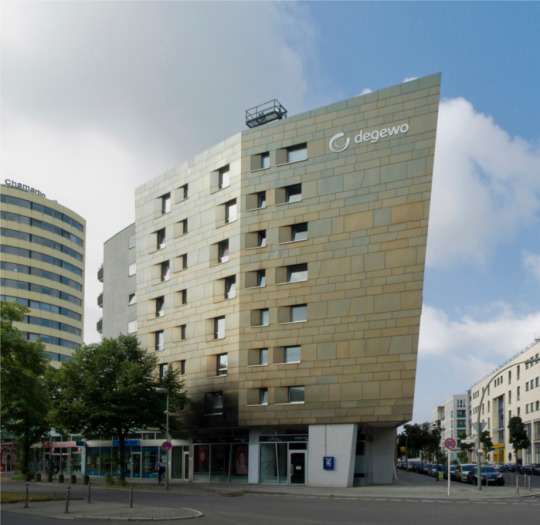
Degewo Residential Building by Zaha Hadid | Photo via ReVision - IBA 1987 exhibition catalog
Myra Warhaftig used this opportunity to put some of her ideas about the connection between housing and women’s emancipation into practice. In 1978, she did a thesis on how the contemporary forms of dwelling contribute to confining women to solitary spaces and duties of homemaking. In Block 2 she built a house of 24 units, each of them equipped with big, central communication spaces where the activities traditionally perceived as women’s work – cooking, childcare – could be combined and shared with other household members. Once the house was built, Warhaftig moved into one of the apartments with her two children. She wanted to personally experience how this space, which she created with the emancipation of women in mind, fits woman's needs. She lived there for the rest of her life. In 2011, a memorial plaque in her honor was unveiled. It reads: "Here, from 1993 to 2008, lived Myra Warhaftig (11.3.1930 - 4.3.2008), architect and architecture historian. This house was designed by her as part of the International Building Exhibition (IBA 1987), as a contribution to the realization of emancipatory living arrangements. With her work, Myra Warhaftig contributed to the memory of Jewish architects who were persecuted, deported and murdered after 1933."
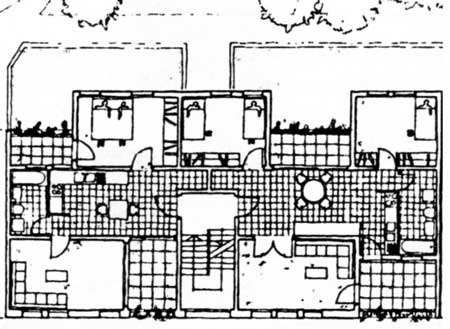
A kitchen as a central element of Myra Warhaftig’s apartments | Photo via frauenwohnprojekte
Christine Jachmann’s focus in this project – resulting in a building of 120 units in lot 3 of Block 2 – was on designing comfortable apartments with rooms that could be used for different purposes, based on individual needs; apartments full of light, with additional household workspaces, open-air areas, and spaces for play in the courtyard. In her reflections on the project, Jachmann notes that communication is an essential factor: “I understand my work in such a way that I listen to and take up the views, demands, and provisions that have been put forward, and the implementation of these within an overall concept falls within my area of responsibility.” She sees the emancipatory living as independent living, as prejudice-free functions and uses of space, and insists on finding new ways to interpret the demands of publicly funded housing construction. The ways of living have changed, she writes, adding: “The needs of people, which are also part of the architecture, are not constant. Everything could always be very different!”
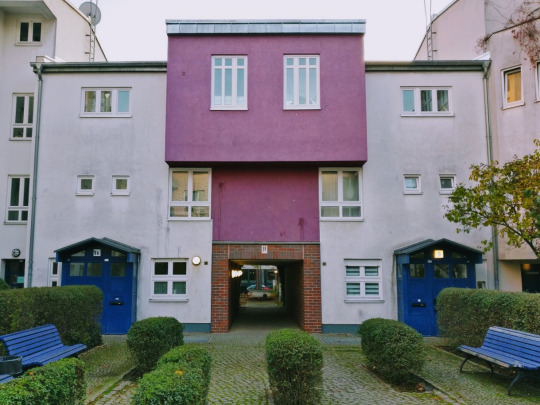
Courtyard view of Christine Jachmann’s building | Photo by Sonja Dragovic
While Block 2 was planned and build from scratch as part of IBA Neubau, many other Berlin blocks – especially in Kreuzberg – were carefully reconstructed within the IBA Altbau program. One of the most famous Altbau projects, Block 70, was redeveloped by Inken Baller and Hinrich Baller, who practiced architecture together until their divorce in 1990. They designed three buildings to fill in the street façade, which had vacant voids in numbers 28, 38 and 44, and a fourth building in the courtyard. New apartments – 87 of them – were built in addition to around 200 renovated dwellings, which were done with the help of student groups, social and labor organizations and housing cooperatives. This self-help approach helped to reduce the costs of reconstruction, but also promoted direct engagement of future dwellers in the creation of their living spaces. Architects’ unorthodox approach, resulting in Block 70’s bright-colored facades and upturned balconies amongst lush greenery, made the project instantly recognizable and quite famous. As Peter Davey wrote in 1987, “the flamboyant expressionism of the Baller work made it the most popular of all IBA buildings in a poll carried out by a city newspaper.”
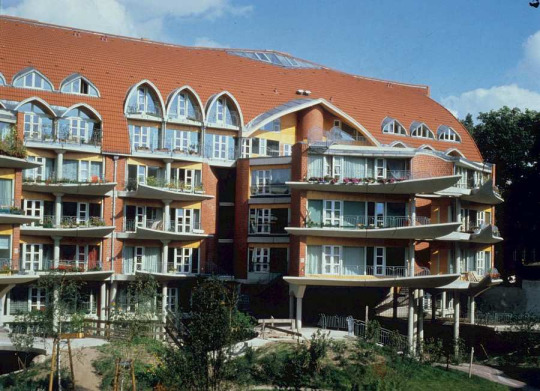
View of the new residential buildings in the inner Block 70 area, 1984 | Photo via Friedrichshain-Kreuzberg Museum
In an interview conducted by Dagmar Jäger in 2000 Inken Baller, an independent architect and a university professor at the time, reflected on the question of decoration for which her work and cooperation with her ex-husband became recognizable: “There is, in fact, no such thing as architecture without decoration. Even in the most reduced form, a detail or the material itself becomes decorative. Man has a desire to develop something beyond the merely unconditionally necessary, and this is the beginning of decoration.” She lists philosophers Ernst Bloch and Susanne K Langer as important influences and sees architects as socially responsible for answering the question of how we should live in the future, for striving for a concrete utopia. She subscribes to a plebeian architecture – not as populist or superficial, but multi-layered: “functional and irrational, simple and elaborate, planned and surprising, cost-efficient yet full of luxurious attributes, easy and difficult, i.e., leaving the thinking in yes/no and leading to thinking of both/and.”

Block 70: floorplan by Hinrich & Inken Baller | Illustration via Pinterest
What made the work of reconstruction within IBA Altbau framework challenging, and what also made its results impressive, was the diversity of communities cooperating to rebuild their blocks. An important contribution to this process was made by Heide Moldenhauer, a woman of many talents, who was responsible for the renovation of IBA’s Block 76/78. She studied architecture in Stuttgart and sociology in Berlin and worked for five years in DeGeWo housing in Wedding before she quit, disappointed by the violent approach in dominant practices of urban renewal. She accepted an invitation to work for IBA, though, as the Altbau renovation approach revolved around cooperation with residents. Since she was a member of a communist organization and had worked on the pro-abortion bill, an anonymous letter was sent to IBA demanding her dismissal – but Hämmer, the director of IBA Altbau, and Werner Orlowsky, the mayor of Kreuzberg, stood by her side. This and other stories about Moldenhauer’s life and work are told in Esra Ackan’s book Open Architecture: Migration, Citizenship and the Urban Renewal of Berlin-Kreuzberg by IBA 1984/87 (2018).
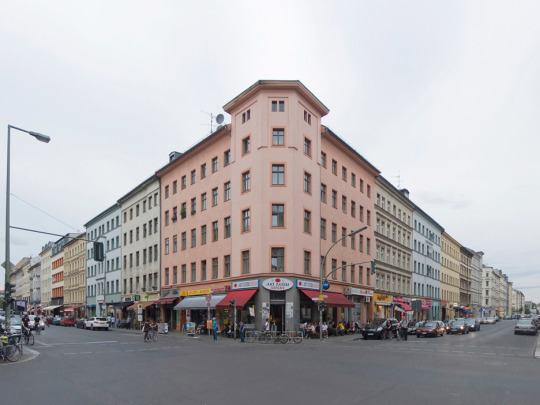
Block 78: Heide Moldenhauer was appointed as the architect responsible for the urban renewal of this area. | Photo by Gunnar Klack
On the importance and the progressiveness of Heide Moldenhauer work in IBA, Ackan writes:
“The participatory architecture, self-help projects, photographs, building programs, public art installations, exhibitions and events that Moldenhauer designed, produced and organized during this process not only stand as unique examples of feminist practice, but also avoid the common forms of imperial feminism and ethnographic authority during the period. After working on the general planning, she became responsible for Blocks 76 and 78, in the Kottbusser Tor area, between Oranien-, Waldemar-, Naunyn-, and Adalbertstrasse and the Oranienplatz. She took about 3,500 diapositives on the streets, in the Hof-spaces and apartments, and during the tenant meetings and the renovation process, amassing a collection which now stands is nothing less than a sophisticated city archive of the period. (…) The first empty unit renovated under her responsibility in block 76 served as a model apartment, used to gain the public’s trust. Block 76 was also the exemplary project introduced in IBA’s most visible Idee Prozeß Ergebnis exhibition catalog, where its 424 out of 551 occupied units accommodating collectively 1165 residents out of which 770 were noncitizens and 456 where children illustrated the housing problem in numbers, while Moldenhauer’s photographs provided the same evidence in images.”
Moldenhauer worked to ensure that the renewal project in Kreuzberg was opened to the ideas and needs of women and noncitizens – that their traditions can become part of the process, integrated in the way that serves them best. She encouraged and oversaw the creation of spaces for women and acted as a mediator between the noncitizen communities and social services. She also took great care of common spaces and encouraged designs that supported the ways in which residents were already using their hallways, gardens, and rooftops.

German-Turkish artist Hanefi Yeter designed murals with scenes from everyday life on the facade of one of the blocks Heide Moldenhauer was responsible for during the urban renewal. | Photo by Esra Ackan
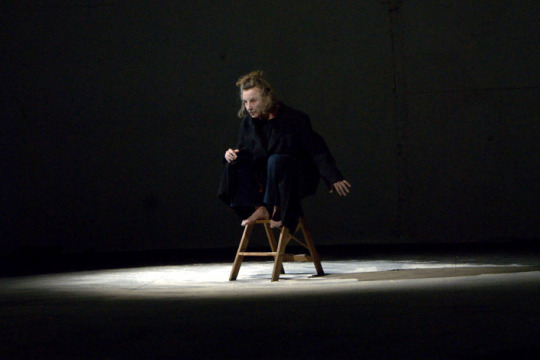
Heide Moldenhauer, the dancer | Photo via flairberlin
Later in her life, Heide Moldenhauer became a dancer – and not just any dancer, but a driving force in the Berlin improvisation scene. According to Ackan, she had her first dance performance on her 60th birthday. In 2010, Tanz Fabrik in Berlin announced one of her show along with this biography: “Heide Moldenhauer was born shortly before the Second World War, learned various subjects until she discovered dance and performance and in 1999 performed her first full-length solo. She mainly shows solos, highly structured or completely improvised, and she sometimes teaches – so far in the cities of Berlin, Bremen, Dresden, Hildesheim, London, Petersburg, Roccatederighi, Tuscania. What you see today has been pulled out of the hat.”
These women influenced contemporary residential development in Berlin by pushing to make the process more aspirational, more inclusive, and better adapted to various needs of the city’s rapidly changing community. Their work improved IBA’s 1984/87 program and created a lasting legacy. We can only guess the ways in which IBA’s history would be altered by a more prominent and numerous presence of women from all backgrounds and communities, at every stage of the design process.
It may be difficult to imagine how merely 40 years ago women in architecture had to struggle to get a chance to work on a project like IBA, which was designed to be inclusive and all-encompassing. But that was the case, and actually, it still is. This week we celebrate the fact that the Pritzker Prize 2020 was awarded to a team of two women – Yvonne Farrell and Shelley McNamara. There are still many glass ceilings to be broken. While we strive to do that, it is important to know and tell the stories of those who came and broke them before us, for us, so that our world gets a bit better and our work a bit easier.
10 notes
·
View notes
Text
Find a Wedding Photographer
Discover a Wedding Photographer intends to make the overwhelming possibility of picking the ideal picture taker for your wedding into a simpler and less confounding cycle. These days there is a tremendous scope of wedding photography styles, bundles and value contemplations. From an unpretentious narrative narrating approach - in some cases called Reportage wedding photography - to inventive, imaginative, presented wedding photography that many allude to as Fine Art wedding photography.
For some couples, the expense might be the most significant factor, and we additionally give a snappy 'demand a statement' administration that is an extraordinary method to check accessibility and get a manual for the value you can hope to pay for a top neighborhood proficient close to you.
We are pleased to have the best organizations in the UK recorded in our registry pages. We additionally have the best authority narrative narrators and low financial plan, moderate camera administrators in discrete areas making it considerably simpler to find the ideal wedding picture taker for you.
On the off chance that you are searching for wedding motivation, you'll discover loads of tips and guidance accessible on our celebrated wedding blog, incorporating genuine weddings with genuine ladies captured by top experts at a portion of the UK's most renowned wedding settings. So on the off chance that you are searching for a chic, fashionable person London wedding picture taker for your stylish metropolitan wedding in Shoreditch or an imaginative, inventive wedding photography group for under £1000 for your wedding in Scotland - you'll see them here.
Recall that numerous providers are eager to travel significant distances for the correct customer thus on the off chance that you are anticipating getting hitched abroad, at that point you don't have to confine your self to looking locally. View our Destination wedding photography catalog - it's consistently worth reaching somebody whose style you like, to check whether they are accessible for your large day.
1 note
·
View note
Text
Why Reportage and Documentary Styles Are Perfect for Wedding Photography
Reportage and documentary styles have become increasingly popular in wedding photography for their ability to capture genuine, spontaneous moments. Unlike traditional posed images, these styles focus on documenting your wedding as it naturally unfolds, providing an authentic representation of your special day.

A reportage wedding photographer specializes in capturing candid moments, blending into the background to observe and document real emotions and interactions. This unobtrusive approach results in a collection of images that reflect the true story of your wedding, including the laughter, tears, and often-overlooked details.
Similarly, a documentary wedding photographer creates a visual narrative of your day. Instead of staging shots, they aim to tell your unique story through a series of images that capture the progression of events from start to finish. This approach provides a timeless, personal story that you can relive through your wedding album. To know more, Read this blog.
#Reportage wedding photographer London#Documentary wedding photographer London#Exhibitions photography london
0 notes
Text
Benefits Of Hiring The Professional Wedding Photographer In London
One of the simplest parts about your wedding is having the ability to seem back on the events a couple of years down the road. Whether you would like to send pictures to your friends and family who weren't ready to make the event, otherwise you want to possess your photograph framed and put round the house; you would like these mementos to seem as grand and professional as possible. That’s why most couples accompany knowledgeable engagement photographer in London once they are looking to urge married. And here are a number of the main benefits of hiring these pros:
Stunning Photos
When you deal with a Professional Wedding Photographer in London, you're getting the simplest sort of service possible. They’re going to do everything in their power to make sure your wedding photos look gorgeous. Wedding photographers take their job very seriously, which suggests they're going to scout your venue and confirm they know exactly where to snap pictures from. They’re those who can notice the tiny and sometimes important details you'll not recognize when it involves getting the right wedding photos. You always have a lover take pictures at your wedding, but would their lack of experience end in a substandard final product? Probably.
Knowing When to Snap an image
Having a top-quality camera isn't something difficult to realize lately. When our smartphones boast cameras with over 20 megapixels, it's hard to seek out someone who doesn't have a world-class camera in their pocket. But having a high-end camera doesn't make a photographer. Knowing when to require an image is that the primary reason some photographers are better than others. Expecting the precise moment before snapping on the camera is what separates average photographers from the simplest. And you are doing not want someone average photographing your wedding.

Styles
There are many various styles you'll select once you invite Wedding Photography Services. Some prefer the normal style, where your photos are getting to look as natural and professional as possible. But you'll also choose between reportage and contemporary styles. Reportage photos look more sort of a journalist's snaps, while contemporary photos are ideal for bridal magazines and other such publications. You’ll always speak with the photographer beforehand about your demands on the design of their photos.
Peace of Mind
You can relax at your wedding knowing there's something you trust taking pictures of the entire event. Your photographer isn't getting to get swept up within the moment or start chatting up someone at the event. They’re at your wedding to try to employment and that they will confirm the work is completed one hundred pc correctly. And you'll get your wedding photos delivered to your physical and digitally during a matter of days. It’s hard to seek out this sort of service from amateur photographers.
If you would like your wedding photos to seem stunning, it's time to rent knowledgeable who has the experience to offer you such an outcome.
For more info :- Luxury Destination Wedding Photographer in London
Visit Us Social Media Update’s :-
https://www.instagram.com/cesarportesphoto/
https://www.facebook.com/CESARPORTESphotography/
1 note
·
View note
Video
youtube
Shannon & Ettiene's Epic Leez Priory Wedding Video Highlights | Boutique Films & Photography
The Southeasts most experienced wedding videographer & photographer team.
Boutique Weddings are a creative Essex & London Leez Priory wedding videographer and photographer team. Working throughout the Southeast, Kent Surrey Suffolk, Herts/Hertfordshire plus the whole of the UK.
Working in a relaxed reportage style Boutique Wedding Films & Photography love nothing more than capturing timeless Leez Priory wedding Videos for our couples.
0 notes
Text
Famous muse Pattie Boyd says she neglected herself in her rock star marriages
10 April 2018 — 10:21am
If you remember the '60s, you weren't there: so it is said of that explosive decade of sex, drugs and rock'n'roll when girls sashayed down the Kings Road in tiny skirts and Biba boots, boys wore ruffled shirts over tight velvet trousers and London was the epicentre of cool.
Oblivion came with the territory: Eric Clapton was supposed to have slept with more than 1000 women but as he told me in an interview for Fairfax Media, "I wouldn't know, I was in a blackout for quite a few of them".

George Harrison and wife Pattie Boyd.
Photo: Keystone Pictures USA / Alamy Stock Photo
Pattie Boyd was both muse and wife to Clapton, to George Harrison before him and no stranger to drug and booze-fuelled partying. But there was little danger of failing memory for her. She kept a record of the wild years – portraits and reportage style snaps taken with a Polaroid and, later, on a Hasselblad.
As fans and paparazzi clamoured at the door, Boyd had the inside track, hanging out with The Beatles and friends, at home with George, on tour with Eric. "I took endless photos," she says. "It was something to do, otherwise you could feel a bit spare."
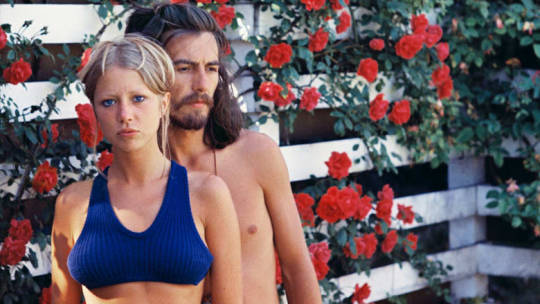
Pattie Boyd and her then husband George Harrison in England in 1968.
Photo: Pattie Boyd
We are talking in her Kensington flat ahead of an exhibition of her photographs and a series of speaking engagements in Australia in May. I'd spent several minutes on the rather grand doorstep, repeatedly ringing the bell and wondering if I'd got the wrong address. Perhaps she'd been having a nap; she is 74 after all and it is that snoozy, post-lunch time of day when I often feel like one myself. She does seem quite dreamy, half-heartedly remonstrating with a friendly Irish terrier called Freddie who inspects me thoroughly before jumping onto a large pouffe, not quite as pristine white as the matching sofas. "He's allowed on that one," she says.
Boyd is wearing skinny jeans on her long, slim legs and a deep blue mohair jumper; a fall of blonde hair frames what is still recognisably the face that launched, not a thousand ships, but three of the greatest love songs of the 20th century.
George Harrison wrote Something in the first flush of his youthful marriage to Boyd; the soaring guitar chords of Layla expressed Clapton's yearning obsession with his friend's wife. Then, when he had won her, he wrote Wonderful Tonight – and who hasn't danced dreamily to that, wrapped in a lover's arms?
There is a photograph of a 19-year-old Boyd in the flat: blonde fringe, huge blue mascara'd eyes and a tiny Union Jack stuck on the end of her nose. It is from a weighty coffee table book, Birds of Britain, containing portraits of London's posh totty – society girls who roamed the bars and vintage clothes stalls of Chelsea. Boyd's face is on the cover.
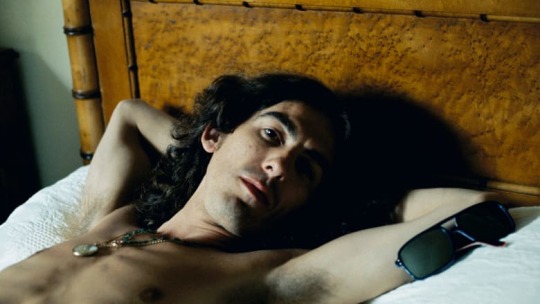
George Harrison, 1968
Photo: Pattie Boyd
She was a model then, on the run from her dysfunctional family, broke and living on Birds Eye chicken pies in a shared flat. "You had to go round the photographers persuading them to use you for shoots," she says. "Norman Parkinson said, 'Come back when you've learned to do your hair.' It was all DIY hair and make up back then."
Did photographers hit on her? "Well some might try it on but you didn't submit and say, 'Oh must I?' You'd get out of there and warn the others." So it wasn't a #MeToo scene? "No! I don't know why these women don't just say, 'F--k off, I'm not having a meeting with you in your dressing gown with nothing on underneath.'" Is she a feminist? "Well not in the old 'hate men' way, but I don't like women being treated badly. I think the young generation – what are they called, snowflakes? – don't take responsibility for themselves."
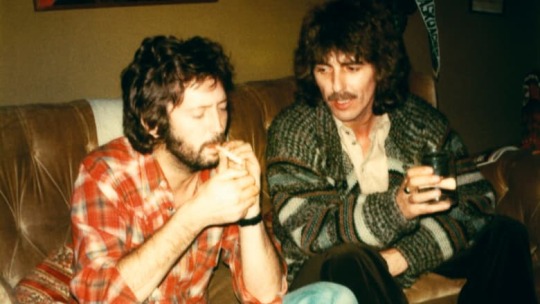
George Harrison and Eric Clapton in England in 1976.
Photo: Pattie Boyd
She met George Harrison on the set of A Hard Day's Night – she played a schoolgirl – and they married when she was 21. They moved into Friar Park, a gothic pile in Hampshire where the Beatles came to record, friends drove from London to stay and she threw herself into decorating, cooking and entertaining. She was, she says, blissfully in love but often lonely: wives and girlfriends were not allowed on tour and Harrison was frequently absent. After the Beatles had discovered the Maharishi Yogi and they all went to India to learn meditation, Harrison returned gripped by eastern mysticism. "He chanted a lot," she recalls, "it's difficult to talk to someone who's chanting."
He had also discovered that he was attractive to women: "He was famous, good-looking, had tonnes of money and flash cars – what a combo. Girls were offering themselves everywhere and he loved it. To come home to old wifey must have been a bit dull."
I took endless photos. It was something to do, otherwise you could feel a bit spare.
Does she think all men would be like that if they could? "Yes I do," she says firmly. What constrains them? She shrugs: "Society, women, family?"
Eric Clapton had been a frequent visitor to Friar Park, laying siege to Boyd and, famously, playing a guitar "duel" with Harrison in the kitchen: she was the putative prize. "It was John Hurt [the actor] who described it as a duel," she says, "and he was so on the button. I sensed it but I hadn't formulated it."
She was attracted to Clapton, by then a rock deity – the legend "Clapton is God" was spray-painted on city walls – but determined to stay in her marriage. Her parents had split up when she was 10, her stepfather was a cruel and unusual man who tyrannised the family and left her mother for another woman: "As a child I always thought I would do anything to avoid divorce."
By the time she left Harrison – "He didn't want us to be together, it was a life of rejection" – Clapton had made good on his threat to take heroin if he couldn't have her. It would be four years before they got together.
Propped on an easel beside the window of Boyd's flat is a rather beautiful black and white photograph of John Lennon. Did she take it? "No, I bought it." Wasn't he the most interesting of the four? "He was, yes, he was. He was quite volatile, you never knew what he would say next. He was a pretty sexy guy actually." Did they have a fling? "No!" she exclaims. I explain I'd seen it suggested somewhere in a newspaper article. "How cheeky," she says comfortably. Later, reading her autobiography published in 2007, I find another reference to the rumoured liaison. True or not, I don't think she minds the idea.
Boyd and Clapton married in 1979: "I was madly passionate about him," she says. "We lived at Hurtwood Edge [Clapton's home for the past 50 years], I was in my 30s and ready to have babies; I used to wander round the house thinking, this will be the baby's room, the nanny can sleep here." But it was not to be: despite visits to a series of doctors and several rounds of IVF, the longed-for baby never arrived.
Clapton, meanwhile, had replaced heroin with alcohol and was drinking heroically. Boyd joined him on tour where he and the band would have girls to their rooms after the show. Cruellest of all, two of his extra-marital relationships produced babies: a daughter Ruth and two years later a son, Conor, who would die, aged four, in a fall from the window of his mother's New York apartment. Boyd and Clapton divorced in 1988.
Asked once who was the great love of her life, Boyd nominated Harrison: "I think he always loved me … Eric loves himself. She admits now: "In both my marriages I had neglected myself, and got lost in a big cloud of fame, I got lost in their lives."
When the music stopped Boyd found herself with a legacy – cardboard boxes full of photographs which she exhibits and sells as prints from her online gallery. They are the archive of an era: here is an angelic George lying in bed in an Indian ashram, Eric in a woodshed leaning on an axe and looking Lawrentian in corduroy trousers, Paul and Linda McCartney at Boyd's wedding to Eric, Anita Pallenberg and Marianne Faithfull at the Brixton Academy. They are candid and intimate: did anyone ever object? "No, not at all," she says, surprised, "I would never show a photo where someone's not looking good."
The collection has been a useful earner for the girl who left school with three O levels and had no need to work while married to rich men. She has continued to take photographs – portraits of actors for their books and pictures from her travels. Does the contemporary work sell? "No one's really interested," she says without rancour.
Freddie needs a walk so we put on coats and set off for Holland Park where the trees are still leafless but there are daffodils and a hint of spring. Boyd has been with her partner, property developer Rod Weston, for 20 years – "we are old friends" – and they wed in 2015. They share the Kensington flat and a cottage in Sussex bought for her by Clapton. Why did they decide to marry? "We have lots of nieces and nephews between us," she says, "we wanted to put everything in order so there wouldn't be any tears." We walk on a few paces: "It's funny," she says, "Rod has been much nicer since we married and I am happier and less selfish. I didn't anticipate that."
She remained friends with Harrison until his death from cancer in 2001 and has stayed in touch with Clapton, many years sober and married with three more children. Last year she accompanied him to the launch of a documentary about him, A Life in 12 Bars, in which she features, naturally. "He rang me and said, 'It's a bit raw Pattie, I hope you'll be OK.' I said, 'I'll be fine Eric. I'm a grown-up now."
George Harrison, Eric Clapton and Me: An Evening with Pattie Boyd will be held at Sydney's Four Seasons Hotel on May 15. Boyd's work will be shown at the Blender Gallery in Paddington from May 5 to June 2 as part of the Head On Photo Festival.
Morning & Afternoon Newsletter
Delivered Mon–Fri.
https://www.smh.com.au/entertainment/music/famous-muse-pattie-boyd-says-she-neglected-herself-in-her-rock-star-marriage-20180409-h0yi6e.html
28 notes
·
View notes
Link
Looking forb the best Wedding Photography team in Dubai? Chandan Sojitra is a Visual Storyteller from Dubai servicing weddings throughout the local area including Abu Dhabi, Ajman, Ras Al Khaimah & destinations abroad. He is a reputable Wedding Photographer in Dubai and has been a part of the Photography & Videography industry since 2010 specializing in Photojournalism, Documentary, and Reportage styles. Get in touch with us for a reliable Wedding Photography in Dubai at an affordable package. Take a look at our stunning Wedding Photography in Dubai and also from across the globe including; London, Paris, Norway, Italy and more destinations. Enquire with us at [email protected].
0 notes
Text
The Best Professional Luxury Wedding Photography in London

Get Luxury Wedding Photography in London. Personally, the people, only want excellent photography in their function. Terry Li Photography showcases the best high end, best range, and luxury style wedding photographers from around the UK. Their styles range from standard reportage to modern wedding photos. Kindly, get in touch on +44(0)7774524804.
0 notes
Text
Documentary Photography:
I would like to explore and learn more about a career behind a documentary style of photography using my interests in portraits and landscapes. Since I studied photography at college where I would document my friends when I was 16 years old, I explored the work of Gavin Watson and his series Skins. He documented and took portraits and combined landscapes of the lives of these group of kids turning into adults. I used his influences to document and photograph my friends at the time where I explored their relationships with their family and friends which helped me get a closer insight into their lives. When doing this I found it was research into the life of teenagers and how society and social influences impacted them. Digital photography had just started there wasn’t photoshop or social media at the time, the main influences in their lives was the way they grew up and the impact of the media from television or newspapers.
Since leaving college and becoming a parent I had to grow up really quickly and since digital photography has grown and with the influence of social media in today’s society, I can see a much stronger influence with photography and how it has an impact on people. I have explored taking wedding photographs and portraits as a freelance photographer but didn’t have enough experience and knowledge. I was taking photographs for the sake of it wedding photographs and portraits but didn’t feel any passion in my work which therefore lead me to start my learning process at uni. I have photographed my children a lot and explored social medias influence on them with a few of my projects each term. I would like to continue doing this by expanding my knowledge and learning more about documentary photography by using landscapes and portraits.
“Documentary photography is a style of photography that provides a straightforward and accurate representation of people, places, objects and events, and is often used in reportage” Taken from the Tate website.
There are a few photographers who use documentary style photography which have influenced me:
Gavin Watson
Sally Mann
Dorothea Lange
Robert Frank
Dana Lixenburg
Doing my research I came across a photographer called Amelia Allen who is a fashion, portrait and documentary photographer based in London. She actually never did a photography degree she only had an A-Level in photography however she explains that it was work experience being a photographers assistant which helped her gain her experience and knowledge in photography. She explains how you need to look into all areas of photography not to limit yourself and not to ever turn down opportunities. Naked Britain was one of her series where she documented a naturist camp where she explored body images and self-confidence. The project a series of black and white photographs which was different from her fashion photography of the perfect body, she explored and celebrated the real body image and it encouraged her to embrace her own body. These images are very intimate which is what I love about documentary you can really learn and understand more about people and this shows in the photographs created. She is also in the process of creating a project called Birth where she has photographed a couple giving birth part of this series where you get this most personal intimate time documented through photography.
https://www.ameliaallenphotography.com/703546
Looking at questions I need to ask myself to get myself started once I finish University to embark on my career in photography. I need to embrace documentary as portraiture and landscape photography and doing this I would also need to look into assisting a photographer to gain work experience in these fields. Amelia Allen is a fashion photographer but uses her experience and knowledge to take documentary work. Therefore I need to be open to the idea to explore my range in documentary. Assistant photographer is where you assist the photographer in completing photo sessions, the level of entry for this role involves helping and preparing photos for distribution, operating photographic equipment and technical as well as creative advice to the photographer. Looking on job websites for assistant photographer you get a huge criteria of different styles pf photography assistants for example:
Junior Photographer Assistant:
You will be joining a Digital Design Department and art team closely working with other creatives and product teams in the business such as photography, copywriters, web developers, video making, and product development.
What you'll be doing...
· Produce high quality images which are correctly exposed and colour consistent
· Support the lead photographer build sets and organise photoshoots
· Make sure products are lit correctly in accordance with our guidelines
· Be responsible for the care and upkeep of all studio equipment, props and supplies
· Archive digital assets
Essential Skills – Abilities
· Knowledge of cameras(canon) and studio lighting techniques
· Fluency in Photoshop, Capture One and Adobe Bridge
· Commercial studio experience
· Capacity to work under tight deadlines
· Experience with fashion/lifestyle photography a bonus
· Must be proactive and take initiative
Portfolio required
Experience – Photography experience will be preferable.
A portfolio is essential and I would need to start thinking about having some sort of website or link to show some of my work.
Amelia Allen using this recent photographer as an example has a clear website which shows her portfolio very clear and the work she has done. I have sent an email to Amelia asking for her advice as to where I go to start myself in the area of portrait documentary.
I stumbled across Rachel Rimell award winning London family documentary photographer who I have also emailed asking for advice.
https://rachelrimellphotography.co.uk/
She has her website that gives clear look at her portfolio and explains her experiences. She states on her website her prices.
A snap shot session she charges £185 which includes:
• 1-2 hour session at home or location
• Personal pre-session consultation
• Personal gallery-viewing/ordering session
• Prints, digital images and or art products are purchased separately.
An in depth documentary session at £375 includes
• 4-5 hour session at home or location
• Personal pre-session consultation
• Personal gallery-viewing/ordering session
• Prints, digital images and or art products are purchased separately.
An intimate session at £750 includes:
• 8-10 hour session at home or location
• Personal pre-session consultation
• Personal gallery-viewing/ordering session
• Prints, digital images and or art products are purchased separately.
To tailor your photography needs after she charges this prices afterwards:
Digital Collection £695 which includes:
• All edited full resolution digital images
• Presentation USB and download
• Full print rights
The Print Collection:
• Four mounted fine art prints size 10x8
• All digital images for download
The Heirloom Collection:
• One 40 page heirloom fine art photobook
• All digital images on presentation USB
• Keepsake presentation box
A La Carte:
• Fine art prints from £60
• Framed prints from £225
• Art from £225
Understanding how to charge what prices depends on experience and completion in the industry but I would need to start out by assisting a photographer to understand how.
In order to do this I will send out my cv where I have edited and constructed my photography knowledge and together put a portfolio of my work. I need to edit my portfolio maybe even reshoot some work to contribute to the style of photography industry I would like to get into. Having researched I have realised I wonder need to broaden my photography ideas and can use my style of documentary to put my own twist on the industry ie: documentary wedding photography instead of the standard posed photographs, documentary portraits and landscapes. Assisting a photographer I think would be relevant work experience to help my understanding of the industry and what to expect. I can gain knowledge and platform to start working in the industry like the above photographers and use my knowledge and ideas to freelance on the side.
0 notes
Link
Modern stylish cinematic wedding films and photography throughout Essex London, Kent Surrey Suffolk, Herts/Hertfordshire plus full UK and destination weddings.
Working in a relaxed reportage style Boutique wedding films and photography are unique outstanding Greenswoods Hotel & Spa photographers and videographers capturing priceless memories time after time for wonderful newly weds. If you enjoy our work then please don't hesitate to get in touch via the link below to check our availability.
0 notes
Text
I am a wedding photographer
I came across a wedding photographer whose seemingly apoologetic strapline was "I am not a wedding photograper". But he was.
This photographer is obviously experiencing some sort of existential career disappointment. He would so clearly love to be considered an arty photographer, with an exhibition in a trendy London gallery, with fawning articles about him in the BJP and with all the high-paying advertising commissions that go with it. But he isn't.
I guess his strapline might be designed to say to customers that he isn't the sort of old-fashioned wedding photographer who only does line-ups. (People still want line-ups by the way). But those photographers died out with ham on melon and steak diane quite a long time ago. Every wedding photographer these days does the sort of candid, reportage, documentary (call it what you will) photography that he's suggesting he does uniquely. He doesn't.
Underlying all this seems to be a sense of shame that he's doing wedding photography at all. OK, so it's partly because it's not paying Rankin levels of fees. But I sense it's also because his clients are just normal people. If he were shooting Will and Kate's wedding, would he be so apologetic about his job?
Why not take pride in the job? Wedding photography is a tough job, requiring - if you do it well - all the creative skills of an arty BJP photographer or a street-wise documentarist. I sometimes think many photographers don't like doing weddings, not because it's not a creative job, but because the consequences of getting it wrong are so dire. You can't get the bride to walk down the aisle twice if you miss the shot. People think being a wedding photographer is easy and boring. It isn't.
0 notes
Text
South London Wedding Photographer - Jonny Donovan Photography
Jonny Donovan, a South London wedding photographer, specializes in capturing the authentic emotions and unique moments of your special day. With a natural, candid approach, Jonny ensures that your wedding photos reflect the true essence of your celebration. Whether it’s an intimate ceremony or a grand event, Jonny’s expertise in South London’s diverse settings ensures stunning images that you'll cherish for a lifetime. Trust Jonny Donovan Photography to beautifully document your wedding day in South London.
0 notes